I started keeping track of interesting developments in furniture design recently. I'm primarily focused on the integration of furniture and technology (call it "smart furniture" ;-). Most of these have been collected from the gadget blogs over the last couple of months, so you may see familiar things if you follow those.
Massage Chairs
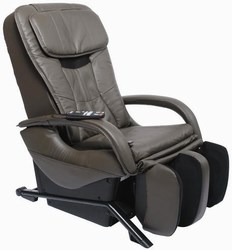
I had just noticed that massage chairs are domestic robots when Matsushita had to recall 68K of them. Now what this means is that there were at 68K massage chairs in the world. That's fewer than the number of Roombas or iPods, but that's a lot of chair-shaped domestic robots, and Panasonic is only one of dozens of brands producing the things.
EL Couch
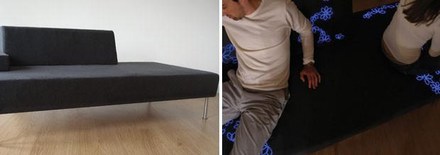
Designer Danielle Sobik has made a prototype reactive electroluminescent couch. I think that her narrative that it's designed to bring couples apart by providing glowing color feedback that they're sitting too far apart is a bit simplistic (OK, so it works once, what's the daily utility) and, frankly, unnecessary: why not just have a couch that glows when people sit on it, and the glow changes depending on the orientation. I think it's also interesting that her goal seems to make the modernist design esthetic of the couch form she's using "more personal." This is a theme that seems to be reappearing recently, and it makes sense to me (but, then again, I'm no fan of Modernist minimalism).
Herman Miller includes charging into desktops
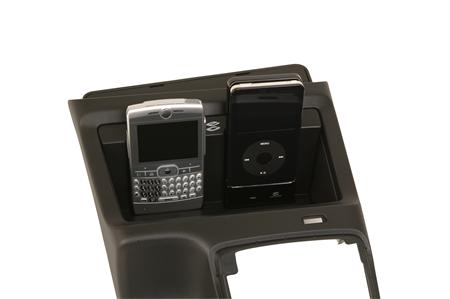
Induction based battery charging (most frequently seen in cordless electric toothbrushes these days) has been one of those technologies that has been possible for a long time, but practical maybe only recently (and maybe not now). Herman Miller's licensing of the technology, and including it into their portfolio of products makes it distinctly more possible. It also creates an interesting technology lock-in problem. This may be the first technology H-M has installed that's tuned to a specific set of devices that the company doesn't make. As those devices evolve, how will H-M update this technology? More importantly, how will they reassure office managers that the desks they're buying today--the very, very expensive Herman Miller desks--won't be "obsolete" 2 years from? This may be the thin edge of the smart furniture wedge, since the drastically different lifecycles of furniture and technology are what have prevented deep inclusion of tech into furniture.
Whirlpool Centralpark
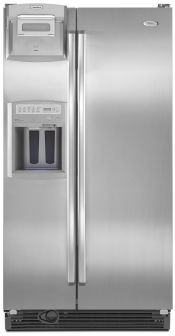
A similar idea is Whirlpool's new fridge/accessory charger. They're being explicit about the pieces being swappable, so therefore trying to make it "futureproof." I'd be interested to see if that'll work, or if the whole assumption that things need to be recharged is going to disappear in a couple of years with new battery technology and induction charging. But that's of course not how Whirlpool's customers purchase: they have iPods today and when comparing Whirlpool's fridge against the Subzero, any slight advantage helps. It'll be interesting to see how well this sells. It's also interesting, because it provides electronics-level power input into the face of a refrigerator, which not only opens up all kinds of hacking possibilities, but also expansion possibilities. The classic "stick an LCD display into the front of your fridge" idea can't be far behind (though probably no one will buy it, as they didn't before).
Finally, a couple of design-oriented technology notes. Exploring the integration of technology into everyday life is the leitmotif of this blog, and the other side of installing technology into everyday objects is making technological objects that already exist better integrated. To that note, here are two fascinating recent examples:
Suck UK's fabric clock
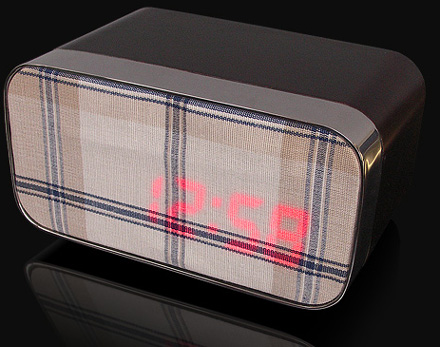
An excellent melding of DIY, ironic anti-Modern design, historical reference (think 1960s tabletop radios) and technological camouflage, a simple idea for a 30-year-old technology and a great use of LEDs. Go Suck UK, go.
Samsung's blinged-out washer
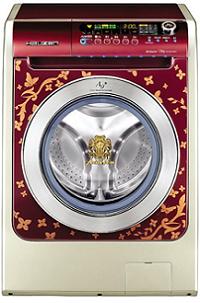
Again, I'm no fan of cold Modernist minimalism. My reasons are many, but--among other things--it no longer make sense to treat the products of technology as if they were from a scientific lab, even when a lot of science goes into making them. That level of communication is no longer necessary, and we've grown used to tech. So much so, that casemodders, the hotrodders of our age, are the vanguard of technology personalization and expression. They show us that bling is a core part of our lives, or it should be. In our hearts, we all bling. Rimless architect glasses and Eames furniture are still bling, they just come from a different social background than gilt and Baroque curlicues. I think it's about time that appliance makers recognized and embraced the latter as a legitimate design style, which is why I'm so happy to see this washing machine. More bling!



